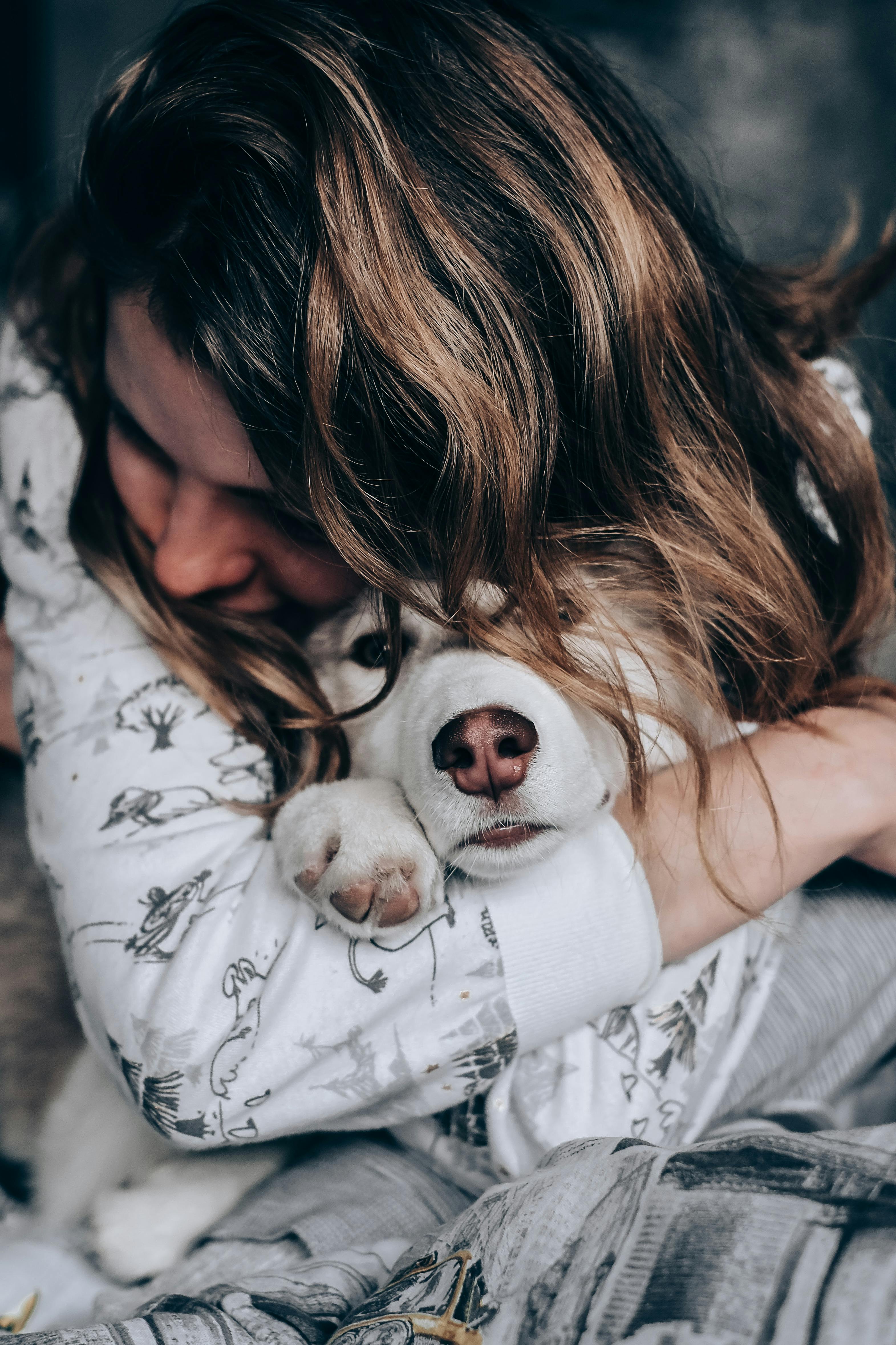Have you ever wondered why do dogs have wet noses? This intriguing question has captivated pet owners and animal lovers alike. A dog’s nose is not just a cute feature; it serves several important purposes. In this article, we will explore the surprising benefits of a wet nose and what it means for your furry friend’s health. Did you know that a dog’s nose can actually help them detect scents better? It’s true! The moisture on their noses helps to absorb scent particles, enhancing their sense of smell dramatically. But that’s not all! There’s a fascinating science behind this phenomenon that many dog owners overlook. You might be curious if a wet nose indicates a sick dog or if it’s simply a sign of a happy and healthy pup. Understanding the reasons behind your dog’s wet nose can deepen your bond and improve their care. So, stick around as we delve into the science and benefits of dog noses. You might just be surprised at what you learn about your loyal companion!
The Science Behind a Dog’s Wet Nose: What Makes it Unique?

When you think of dogs, one of the first things that come to mind is often their wet noses. But have you ever wondered why do dogs have wet noses? It’s a common question among pet owners and animal lovers, and the truth is, there’s a lot of science behind it. Beyond just being cute, a dog’s nose serves several important functions that can surprise you.
The Anatomy of a Dog’s Nose
Dogs have a very unique structure in their noses. The skin on their noses is covered in a layer called the rhinarium, which is usually moist. This moisture is not just for show; it plays a vital role in how dogs perceive the world around them. Here are some points about the anatomy:
- Rhinarium: The moist skin that helps enhance the sense of smell.
- Nasal Turbinates: These are structures inside the nose that increase the surface area, allowing more scent receptors to be present.
- Scent Receptors: Dogs have about 220 million scent receptors, compared to humans who have about 5 million.
Why is a Dog’s Nose Wet?
So, why do dogs have wet noses? It’s because of several reasons that have evolved over time.
- Cooling Mechanism: The moisture evaporating from the nose helps to regulate a dog’s body temperature.
- Enhanced Smell: A wet nose traps scent particles better than a dry one, which helps dogs to detect scents more efficiently.
- Health Indicator: A change in the moisture level can indicate health issues, so a dog’s nose can serve as a simple health check.
The Benefits of a Wet Nose
You may be surprised to learn the many benefits of having a wet nose. Here’s a list of some surprising advantages:
- Improved Sense of Smell: Wet noses absorb scent particles better.
- Thermoregulation: Helps keep the dog cool in hot weather.
- Communication: Dogs use their noses to gather information about other dogs and their environment.
The Science Behind the Wet Nose
Research shows that dogs’ noses are not just for smelling but also for gathering important information about their surroundings. The moisture in a dog’s nose enhances their ability to pick up scents. In fact, dogs can smell up to 100,000 times better than humans! This ability is crucial for their survival instincts and social interactions.
Fun Facts About Dog Noses:
- Dogs can even detect certain diseases through scent.
- The texture of a dog’s nose can vary, with some being smooth while others are bumpy.
- Just like humans have unique fingerprints, dogs have unique nose prints.
Historical Context
Historically, dogs have been used for hunting, herding, and companionship. Their wet noses have played a significant role in their ability to track scents. This evolutionary trait has made them invaluable partners to humans throughout history.
In ancient times, dogs were often used to track game, and their ability to pick up scents was crucial for survival. Even today, search and rescue teams rely on dogs’ incredible olfactory skills to locate missing persons or detect substances like drugs or explosives.
Comparisons Between Dog and Human Noses
Here’s a simple comparison of dog noses versus human noses:
| Feature | Dog Nose | Human Nose |
|---|---|---|
| Scent Receptors | ~220 million | ~5 million |
| Moisture Level | Always moist | Can be dry |
| Functionality | Tracking scents, cooling | Breathing, smelling |
Practical Examples of Dogs Using Their Noses
Dogs use their noses for various practical purposes. For example:
- Service Dogs: Trained to detect medical conditions, like low blood sugar or seizures.
- Detection Dogs: Used by law enforcement to sniff out drugs or explosives.
- Search and Rescue: Help locate missing persons in disasters or wilderness areas.
In addition to these tasks, many dog owners notice that their pets often sniff around during walks or at home. This behavior is not just curiosity, but a complex way for dogs to gather information about other animals, people, and their environment.
With all this fascinating information, it’s easy to see why a dog’s wet nose is more than just an adorable feature. It plays essential roles in their health, communication, and survival. Understanding the science behind a dog’s wet nose not only deepens our appreciation for our furry friends but also reinforces the bond we share with them. The next time you see your dog with that wet nose, remember it’s doing much more than just looking cute!
5 Surprising Health Benefits of Dogs Having Wet Noses

Have you ever noticed your dog’s nose? It’s almost always wet! This peculiar characteristic of our furry friends is not just for show. In fact, there are several surprising health benefits associated with dogs having wet noses. Let’s dive into this fascinating topic to uncover why do dogs have wet noses, and what those benefits are.
Why Do Dogs Have Wet Noses?
Dogs noses are wet for a variety of reasons. Firstly, the moisture helps enhance their sense of smell. Did you know that dogs have up to 300 million smell receptors in their noses? Compare that to humans who only have about 5 million. The wetness on a dog’s nose helps capture scent particles from the air, thus amplifying their olfactory abilities. Also, it plays a role in thermoregulation, helping dogs to cool down their body temperature when they pant.
5 Surprising Health Benefits of Dogs Having Wet Noses
Enhanced Sense of Smell
- Wet noses are more effective at detecting scents. This is crucial for dogs, especially ones that are working in fields like search and rescue, or therapy.
- The moisture actually absorbs more scent particles, allowing dogs to smell things we can’t even imagine.
Temperature Regulation
- Dogs don’t sweat like humans do. Instead, they rely on their wet noses to help regulate body temperature.
- When dogs pant, the moisture evaporates from their nose, helping to cool their body down. This is especially important during hot summer days.
Health Indicator
- A wet nose can often be a sign of a healthy dog. A dry nose, on the other hand, may indicate dehydration or illness.
- Regularly checking your dog’s nose can help you catch health issues early. It’s important to note though, that a variety of factors can influence nose moisture, such as weather or activity level.
Social Interaction
- Did you know that dogs use their noses as a way to communicate? A wet nose can be a friendly greeting when they nuzzle against you or other animals.
- This nose-to-nose contact can promote bonding and emotional well-being for both dogs and their owners.
Natural Cooling Mechanism
- Besides panting, wet noses also serve as a cooling mechanism. They can absorb and dissipate heat effectively.
- This is crucial for active dogs that might overheat during playtime or exercise.
More Facts About Dogs’ Noses
- Composition: A dog’s nose is made up of specialized skin, which is different from the rest of their body. The moisture comes from mucus glands that are present in the nasal tissue.
- Color Variations: The color of a dog’s nose can vary by breed. Some have black noses, while others may have pink or liver-colored noses. This color does not affect their sense of smell, but it can impact their sensitivity to sunlight.
- Nose Print Identification: Just like human fingerprints, each dog has a unique nose print. This can even be used to identify them, though it’s not as common as microchipping.
Fun Comparisons
Here’s a quick comparison between dog noses and human noses:
| Feature | Dogs’ Noses | Humans’ Noses |
|---|---|---|
| Smell Receptors | Approx. 300 million | Approx. 5 million |
| Temperature Control | Yes, helps cool down | No, relies on sweat |
| Moisture Levels | Usually wet | Usually dry |
| Unique Identifiers | Yes, unique nose prints | No, no unique prints |
Practical Tips for Dog Owners
- Regular Checkups: Monitor your dog’s nose for changes. If it becomes persistently dry or cracked, it might be time to consult a vet.
- Hydration: Always ensure your dog has access to fresh water, especially on hot days. Hydration helps maintain that all-important moisture in their nose.
- Playtime: Engage in regular play and exercise, which can promote healthy sweating and cooling mechanisms in your dog.
Dogs’ wet noses might seem like a minor detail, but they are packed with practical benefits that enhance your dog’s health and well-being. From better smell detection to serving as a natural cooling system, our canine companions have evolved to utilize their wet noses in multiple beneficial ways. Next time you see that wet nose, remember that it’s more than just cute; it’s a sign of health and vitality!
Why Do Dogs Have Wet Noses? Exploring the Connection to Their Sense of Smell

Dogs are among the most beloved companions for many people, and one of the most curious features they have is their wet noses. If you ever wondered, “Why do dogs have wet noses?” you’re not alone. It’s a question that sparks interest and a bit of confusion. This article dives into the science behind their wet noses, exploring the connections to their incredible sense of smell and revealing some surprising benefits of this unique trait.
The Science Behind Wet Noses
Dogs’ noses are wet for several reasons, but primarily, it’s to enhance their sense of smell. The moisture on a dog’s nose comes from a combination of secretions from the nasal glands and environmental factors. When a dog’s nose is wet, it can trap scent particles better, which helps them detect smells more effectively. Here’s a breakdown of how this works:
- Scent Absorption: The moisture helps absorb scent molecules, allowing dogs to identify smells more clearly.
- Temperature Regulation: A wet nose can help regulate a dog’s body temperature, keeping them cool while they sniff around.
- Health Indicator: A wet nose is often considered a sign of a healthy dog, while a dry nose may indicate dehydration or illness.
Historical Context of Dogs’ Noses
Dogs have evolved over thousands of years alongside humans, and their noses have become specialized for various tasks. Historically, dogs were bred for specific purposes, and their noses played a crucial role in their abilities. For example:
- Hunting Dogs: Breeds like Bloodhounds and Beagles were developed to track scents, their wet noses aiding in this skill.
- Working Dogs: Many dogs used in search and rescue operations rely on their keen sense of smell, which is enhanced by their moist noses.
Why Do Dogs Have Wet Noses? Discover the Surprising Benefits!
There’s more to a dog’s wet nose than just functionality. Here are some surprising benefits that come from having a moist nose:
Enhanced Smell: As mentioned earlier, a wet nose can help dogs pick up scents much better. They can detect smells at incredibly low concentrations, which is why they can find lost items or even detect drugs or explosives.
Social Signals: Dogs communicate through scent, and a wet nose can also signal to other dogs and animals. They often sniff each other’s noses as a way to gather information about one another.
Cooling Mechanism: Dogs don’t sweat like humans do. Instead, they cool down through panting and having a wet nose. This helps in thermoregulation, especially during hot weather.
Interesting Facts About Dogs’ Noses
Scent Receptors: Dogs have approximately 220 million scent receptors in their noses, compared to about 5 million in humans. This makes their sense of smell vastly superior.
Unique Nose Print: Just like human fingerprints, each dog has a unique nose print. This can potentially be used for identification purposes.
Nose Temperature: A dog’s nose can change temperature based on their health. A cold, wet nose is often a sign of good health, while a warm, dry nose could mean they are sick or stressed.
What Affects a Dog’s Nose?
Several factors can impact the moisture levels on a dog’s nose, including:
- Weather Conditions: Hot, dry weather can lead to a drier nose, while humidity can keep it moist.
- Health Issues: Certain illnesses can cause a dog’s nose to become dry or cracked. If this happens, it’s a good idea to consult a veterinarian.
- Age: Older dogs may not have the same moisture levels in their noses as younger ones.
Comparison with Other Animals
When comparing a dog’s nose with that of other animals, you’ll see some interesting differences:
- Cats: Cats also have wet noses, but they rely more on their whiskers for sensory information.
- Humans: Humans have a much less developed sense of smell, making our noses less moist and less efficient at detecting scents.
Understanding why dogs have wet noses leads us to appreciate our furry friends even more. Their noses not only serve practical purposes but also contribute to their unique ways of interacting with the world. Next time you see a dog with a wet nose, remember, it’s not just cute; it’s a vital part of what makes them extraordinary companions.
The Evolutionary Advantage: How Wet Noses Help Dogs Survive

Dogs have a special charm that many people can’t resist. One of the most curious features of our furry friends is their wet noses. You probably wonder, “Why do dogs have wet noses?” Well, it turns out there’s a lot more to this than just a fact of doggy life. The evolutionary advantage that wet noses provide is fascinating and has significant benefits for dogs in their daily lives.
The Science Behind Wet Noses
First off, a dog’s nose is not just a cute feature. It’s a complex organ. The wetness of a dog’s nose helps it to absorb scent molecules more effectively. When the nose is moist, it picks up more of these molecules, which is crucial for a dog’s sense of smell. Dogs have about 220 million scent receptors compared to a human’s mere 5 million. This makes their sense of smell far superior, and a wet nose plays a big role in this superiority.
- Scent Absorption: A wet nose helps in trapping scent particles, allowing dogs to detect smells much better than humans.
- Temperature Regulation: A dog’s nose also helps to cool them down. Dogs do not sweat like humans do, so they rely on their noses to help regulate body temperature.
- Health Indicator: The wetness of a dog’s nose can be an indicator of its health. A sudden change in moisture can signal illness.
Historical Context
Historically, dogs evolved from wolves, and their survival depended heavily on their hunting skills. Wet noses helped these ancestors detect prey from a distance. Over thousands of years, dogs have been bred for specific roles, but their basic anatomy remains largely unchanged. The wet nose is a trait that has been advantageous throughout their evolution.
Benefits of Wet Noses
You might be surprised by how beneficial this feature is. Let’s break down some of those surprising advantages:
Enhanced Smell: The primary benefit is enhanced olfactory capabilities. Dogs can smell things we can’t even imagine.
Social Signals: Wet noses can help convey emotional states. A dog may greet you with a wet nose to express affection or excitement.
Health Monitoring: Owners often notice changes in their dog’s nose. If it becomes dry or hot, it might signal a trip to the vet.
Communication Tool: Dogs use their noses to communicate with each other. The moisture in their noses can help in picking up pheromones and other scents that convey information.
How Wet Noses Work
So, how does a wet nose actually work? Here is a simplified outline of the process:
- Mucus Production: Dogs produce mucus on their noses, which traps scent particles.
- Vibrissae: These are the whisker-like structures around the nose that help detect changes in airflow, assisting further in their smell detection.
- Nasal Turbinates: The structure within the nose increases the surface area for scent absorption, making wet noses even more efficient.
Comparison with Other Animals
It’s interesting to compare dogs with other animals. For example:
| Animal | Nose Type | Scent Detection Ability |
|---|---|---|
| Dogs | Wet and moist | Excellent |
| Cats | Dry and rough | Good |
| Bears | Wet and moist | Exceptional |
| Humans | Dry and flat | Limited |
As you can see, dogs are in a league of their own when it comes to sniffing things out, thanks primarily to their wet noses.
Practical Examples of Nose Benefits
Let’s put this into context. Imagine you’re walking your dog in a park. The wet nose aids in:
- Detecting other animals nearby.
- Sensing changes in weather conditions.
- Communicating with other dogs through scent.
Dogs with wet noses are not just better at smelling—they’re also more in tune with their environment. This ability can help them avoid dangerous situations, making them more adept at surviving in various conditions.
The question of “why do dogs have wet noses” leads us to understand the evolutionary advantage they’ve developed over time. Wet noses are more than just a quirky characteristic; they are essential for a dog’s survival and well-being. So next time you pet your furry companion, remember that there’s a lot going on with that wet nose—it’s a tool for communication, survival, and health!
Is Your Dog’s Nose Too Dry? 7 Signs You Shouldn’t Ignore

Have you ever noticed your dog’s nose feeling a bit too dry? It’s something many pet owners often overlook, assuming wet noses are just part of the canine charm. But is your dog’s nose too dry? Well, there might be signs you shouldn’t ignore. In this article, we will explore what a dry nose means, why dogs have wet noses, and the surprising benefits of those moist little snouts.
What Does a Dry Nose Mean?
A dog’s nose can tell you a lot about its health. Generally, a cool, wet nose is a sign of a happy, healthy pup. But if your dog’s nose is dry, it could mean something’s not quite right. Here are some signs to look for:
- Cracking or Flaking: If you see cracks or flakes on your dog’s nose, it may indicate dehydration or a skin condition.
- Color Changes: A healthy dog’s nose is usually black or brown. If it turns red or grey, it could be a sign of an underlying issue.
- Excessive Warmth: A warm nose can be an indication of fever, especially if your dog is acting unusually lethargic.
- Swelling: If the nose is swollen, it might be a sign of an allergic reaction or infection.
- Excessive Licking: If your dog keeps licking its nose, it could be trying to soothe irritation.
- Discharge: Any discharge from the nose should raise a red flag; it could be an infection.
- Behavior Changes: If your dog is less active or seems to be in pain, these could be signs that warrant a vet visit.
Why Do Dogs Have Wet Noses?
You might wonder, why do dogs have wet noses anyway? It’s not just for show. Here’s some interesting facts about the biology behind it:
- Temperature Regulation: Dogs sweat very little. They primarily cool off through panting and the moisture on their noses. A wet nose helps them regulate body temperature more effectively.
- Sense of Smell: A wet nose enhances a dog’s sense of smell. The moisture helps to trap scent particles, making it easier for dogs to detect different smells.
- Health Indicator: A wet nose is often seen as a sign of good health. While it’s not a definitive measure, it’s one way to gauge if your dog is feeling good.
Surprising Benefits of a Wet Nose
Wet noses aren’t just cute, they also provide several benefits. Here’s a list of benefits you might not have thought about:
- Enhanced Scent Detection: As mentioned earlier, moisture helps in capturing scents. This is why dogs are often used in search and rescue missions.
- Comfort: A cool, wet nose can be comforting to dogs. It helps them feel more at ease, especially in stressful situations.
- Social Interaction: Dogs often greet each other with their noses. A wet nose can signal friendliness and openness, which is crucial for social bonding among dogs.
When to Seek Veterinary Help
If you notice your dog’s nose is persistently dry, it might be time to consult a vet. Here are some instances when you shouldn’t delay:
- If dry nose is combined with other symptoms: Like fever or lethargy, it’s best to get a professional opinion.
- If you see signs of infection: Such as swelling, redness, or discharge, you need to act fast.
- If your dog is unusually thirsty or not eating: This could indicate more serious health concerns.
Tips for Maintaining Your Dog’s Nose Health
Keeping your dog’s nose healthy doesn’t have to be complicated. Here are some simple tips:
- Keep Hydrated: Ensure your dog has constant access to fresh water.
- Limit Sun Exposure: Dogs can get sunburned, especially those with light-colored noses. Consider using dog-safe sunscreen if your pup will be outside for long periods.
- Regular Vet Check-ups: Annual vet visits can help catch any potential problems early.
In summary, a dog’s nose is more than just a cute feature; it plays essential roles in their health and well-being. If you notice that your dog’s nose is too dry, pay attention to the signs and take action if needed. Understanding why dogs have wet noses can help you appreciate the little things about your pet even more. Whether it’s the way they greet you or the comfort they offer, our furry friends have a lot to teach us about health and happiness.
How to Keep Your Dog’s Nose Healthy: Tips for Pet Owners

Every dog owner knows that a wet nose is a common feature in our furry companions. But have you ever stopped to think why do dogs have wet noses? It’s more than just an adorable quirk of their anatomy; it has some surprising benefits too! Keeping your dog’s nose healthy is crucial for their overall well-being. Let’s explore some tips for pet owners on how to keep your dog’s nose in great condition, while also uncovering the science behind those wet noses.
The Science Behind Wet Noses
Dogs noses are not only wet due to moisture but also because they have special glands that secrete mucus. This mucus helps to enhance their sense of smell. A wet nose can absorb scent particles from the air better than a dry one, making dogs great at sniffing things out. Here’s a few reasons why dogs have wet noses:
- Enhanced Smell: Wetness helps in trapping scent particles.
- Cooling Mechanism: Helps dogs regulate their body temperature.
- Health Indicator: A change in moisture levels can indicate health issues.
Common Nose Problems in Dogs
Just like other parts of the body, a dog’s nose can face its share of problems. Here are some common issues that dog owners should watch out for:
- Dry Nose: Can be a sign of dehydration or illness.
- Cracked Nose: Often caused by dry weather or allergies.
- Discoloration: Changes in color could indicate health issues.
- Nasal Discharge: Excessive discharge might mean infections or allergies.
Tips for Keeping Your Dog’s Nose Healthy
Maintaining a healthy nose for your dog isn’t that hard if you follow these practical tips:
- Hydration: Always provide fresh water to keep your dog hydrated.
- Humid Environment: Use a humidifier during dry seasons to prevent dryness.
- Regular Vet Check-ups: Regularly taking your dog to the vet can help catch problems early.
- Limit Sun Exposure: Just like humans, dogs can get sunburned too. Use pet-safe sunscreen if necessary.
- Clean Their Nose: Gently wiping your dog’s nose with a damp cloth can help remove any debris or irritants.
Fun Facts About Dogs’ Noses
Did you know that dogs have an incredible sense of smell? Here’s some fun facts that might surprise you:
- Scent Receptors: Dogs have about 300 million scent receptors compared to about 6 million in humans.
- Unique Nose Prints: Just like fingerprints, every dog has a unique nose print.
- Nasal Heat Detection: Dogs can detect changes in temperature through their noses, which helps in finding food or detecting prey.
What If Your Dog’s Nose Is Too Dry?
A dry nose can be concerning. If you notice your dog’s nose is unusually dry, consider these steps:
- Increase Water Intake: Encourage your dog to drink more water.
- Check for Other Symptoms: Look for signs like lethargy, loss of appetite, or unusual behavior.
- Consult Your Vet: If dryness persists, it may be time for a vet visit.
Why Do Dogs Have Wet Noses? The Surprising Benefits!
The benefits of having a wet nose go beyond just smell. Here’s what a wet nose can do:
- Sense of Touch: Wet noses can be more sensitive to touch.
- Temperature Regulation: Helps in cooling off, especially after exercise.
- Mood Indicator: A wet nose can indicate your dog is healthy and happy.
In Summary
Caring for your dog’s nose is not just about keeping it looking good; it’s about ensuring their health and happiness. Remember, a wet nose is often a sign of a healthy dog, while changes in moisture can indicate potential health issues. By providing proper care, hydration, and regular vet visits, you can help maintain your dog’s nose in optimal condition. It’s a small but important part of keeping your furry friend happy and healthy. Embrace the quirks of your dog, and keep that nose wet for all the right reasons!
Do Wet Noses Mean Healthy Dogs? Understanding the Myths and Facts

When it comes to our furry companions, one of the most common questions dog owners ask is “Do wet noses mean healthy dogs?” Many believe that a wet nose indicates that their pooch is feeling well, while a dry nose might be a sign of illness. But is this really true? Let’s dive into the facts and myths surrounding our pups’ wet noses and explore why dogs have wet noses in the first place.
What’s the Deal with Wet Noses?
First, it’s important to understand that a dog’s nose is naturally wet for a reason. The moisture is often a result of the dog licking its nose, which helps them to keep their sense of smell sharp. Dogs have an incredible sense of smell, and their wet noses helps them absorb scent molecules more effectively.
But the idea that a wet nose equals a healthy dog is not entirely accurate. Here’s some key points:
- Nose Temperature: A dog’s nose can be warm or cool, and this variation doesn’t really correlate with their health status.
- Humidity and Environment: Weather can play a big role in how wet or dry a dog’s nose is. If it’s hot outside or if your dog is indoors with heating, their nose might be drier.
- Activity Level: After a good romp in the park, your dog might have a wetter nose due to licking or panting.
The Myths Surrounding Wet Noses
So, let’s bust some myths, shall we?
Myth 1: A wet nose means a dog is sick.
- Fact: A dog’s nose can be wet or dry regardless of their health. Illness can show up in many other ways, like changes in appetite or behavior.
Myth 2: A dry nose always indicates dehydration.
- Fact: Dogs can have a dry nose for various reasons, including being in a dry climate or simply waking up from a nap.
Myth 3: Only certain breeds have wet noses.
- Fact: All dogs, regardless of breed or size, can have wet noses. It’s a natural trait!
Why Do Dogs Have Wet Noses?
The reasons for a dog’s wet nose are pretty interesting. Here’s a quick list of why they are like that:
Cooling Mechanism: Like humans sweat, dogs sweat through their noses and paw pads. A wet nose helps them stay cool, especially on hot days.
Enhanced Smell: The moisture on their noses helps capture scent particles, allowing them to identify smells better. This is why dogs are often used in search and rescue missions.
Communication: Dogs use their noses to communicate with each other and with humans. A wet nose can indicate excitement or affection.
Health Indicator: While not a definitive sign, a healthy dog usually has a moist nose. If it suddenly becomes dry or cracked, it might be worth checking in with a vet.
Surprising Benefits of Wet Noses
You might be surprised to learn that wet noses are not just a quirk of dog anatomy but serve some beneficial purposes. Here are a few:
Scent Collection: The wetness allows dogs to trap scents more effectively, making them better hunters and companions.
Thermoregulation: Helps them regulate their body temperature, essential for their overall comfort and health.
Social Interactions: A wet nose can be a sign of affection — when your dog nudges you with their nose, they might be seeking attention or comfort.
Common Misconceptions About Dog Health
Many dog owners often misinterpret signs of health based on their dog’s nose. Here’s a quick comparison of what to look for:
| Sign | Wet Nose | Dry Nose |
|---|---|---|
| Healthy Dog | Common | Possible |
| Dehydration | Unlikely | More likely |
| Illness | Not necessarily | Not necessarily |
| Need for Vet Visit | Not always | Potentially |
It’s crucial to look at the whole picture when assessing your dog’s health. A wet nose is just one aspect of many.
As a dog owner, it’s essential to understand that while a wet nose can be a sign of health, it’s not the only indicator. Always observe your dog’s behavior, eating habits, and overall demeanor. If there are any concerns, don’t hesitate to reach out to your veterinarian. They can provide more insights into your dog’s health based on a comprehensive examination, rather than just relying on the moisture of their nose.
The Role of Temperature Regulation: How Wet Noses Keep Dogs Cool

Dogs are some of the most beloved pets around the world, and their unique characteristics often spark curiosity among pet owners. One of the most fascinating features about dogs is their wet noses. But why do dogs have wet noses, and what role does temperature regulation play in keeping them cool? Let’s dive into the science behind those adorable, moist snouts and discover the surprising benefits that come along with them.
The Science Behind Wet Noses
Dogs’ noses are wet for a reason, and it’s not just for show. A wet nose helps dogs in several ways, primarily related to their sense of smell and thermoregulation. When a dog’s nose is moist, it helps to enhance their olfactory abilities. The moisture captures scent particles in the air and allows dogs to detect smells with greater accuracy. This is why dogs are often used in search and rescue missions or for sniffing out illegal substances.
Moreover, their wet noses also play a critical role in regulating body temperature. Dogs don’t sweat like humans do; they primarily cool themselves through panting and the moisture on their noses.
Temperature Regulation in Dogs
The body temperature of a dog is vital for its overall health and wellbeing. The normal range is between 101°F to 102.5°F. When a dog gets too hot, it needs effective ways to cool down. Here’s how that works:
- Panting: Dogs pant to evaporate moisture from their tongues and lungs, which helps to cool their body.
- Wet Noses: As moisture evaporates from a dog’s nose, it cools the blood vessels just beneath the surface, helping to lower their internal temperature.
- Behavioral Changes: Dogs will often seek shade or water if they’re feeling overheated, showing their natural instincts to cool down.
Why Do Dogs Have Wet Noses? The Benefits Explored
Having a wet nose isn’t just beneficial for temperature regulation; it comes with a host of other advantages as well. Here’s a list of reasons why wet noses are essential for dogs:
- Enhanced Smell: A wet nose increases the ability to detect scents, which is vital for hunting and tracking.
- Cooling Mechanism: As mentioned, moisture helps to keep dogs cool, especially during hot weather.
- Health Indicator: A dog’s nose can indicate its health. A dry or cracked nose may signal dehydration or illness, while a cool, wet nose is often a sign of a healthy dog.
Historical Context of Dogs and Their Noses
The evolution of dogs from wolves has made them uniquely equipped to adapt to various environments. Historically, dogs relied on their sense of smell for survival, tracking prey, and avoiding dangers. With domestication, these traits became even more pronounced as dogs started living with humans. The moisture on their noses became a critical adaptation, allowing them to thrive in different climates.
Comparisons: Wet Noses vs. Dry Noses
Let’s break down the differences between wet and dry noses in dogs:
| Feature | Wet Nose | Dry Nose |
|---|---|---|
| Temperature Regulation | Effective at cooling | Less effective |
| Sense of Smell | Enhanced ability to detect scents | Reduced olfactory accuracy |
| Health Indicator | Generally healthy | May indicate dehydration or illness |
Practical Examples of Nose Care
Caring for a dog’s nose can be important for its overall health. Here are some practical tips:
- Hydration: Ensure your dog drinks enough water, keeping their nose moist.
- Avoidance: Keep your dog away from extreme temperatures, as both excessive heat and cold can cause issues.
- Regular Check-ups: During vet visits, ask about your dog’s nose condition, as it can be an indicator of health.
Dogs have wet noses for evolutionary reasons, and it plays a crucial role in their ability to survive and thrive in various environments. Understanding why dogs have wet noses not only helps you appreciate their unique physiology but also encourages responsible pet ownership.
So next time you notice your dog’s moist snout, remember the science behind it and how it contributes to their overall health and happiness. A wet nose is more than just cute; it’s a fascinating feature that has evolved over thousands of years, showcasing the incredible bond between dogs and their owners.
Curious Canines: Why Do Dogs Lick Their Noses and What It Means

Dogs, those curious canines, have a ton of quirky behaviors that often leave us scratching our heads. One of the most interesting things about them is their wet noses. You might be wondering, why do dogs have wet noses? And what’s with all the licking? There’s more to this than just a cute quirk. Let’s dive deep into the fascinating world of dogs and their noses.
Why Do Dogs Lick Their Noses?
First off, you probably noticed your furry friend licking their nose pretty often. But why do they do this? There several reasons behind this behavior.
Taste and Smell Enhancement: Dogs have a powerful sense of smell. By licking their noses, they’re actually helping to pick up scents. It’s like their way of “tasting” the air. The moisture on the nose captures scent particles, making it easier for them to identify what’s around them.
Self-Cleaning: Just like humans wash their hands, dogs lick their noses to keep them clean. Their noses can collect dirt, food, or even bacteria, and licking helps to remove that stuff.
Nervous Habit: Sometimes, dogs lick their noses when they feel anxious or stressed. If your pup is in a new environment or around unfamiliar people, this behavior can be a calming mechanism for them.
Communication: Dogs also use their noses to communicate. A wet nose can be an invitation for interaction or even a sign of submission. If they’re licking their nose in front of another dog, it might mean they’re trying to diffuse tension.
Why Do Dogs Have Wet Noses?
Now, let’s tackle another burning question: why are dog noses wet? You might think it’s just a random occurrence, but there’s a scientific explanation for it.
Moisture for Scent Detection: As mentioned before, a wet nose helps dogs detect scents better. The moisture allows the nose to absorb scent particles, which is crucial for their survival instincts. In fact, dogs’ noses contain special glands that produce this moisture, making it easier for them to sniff out food, other animals, or even people.
Temperature Regulation: Dogs don’t sweat like humans do. Instead, they regulate their body temperature through panting and the moisture on their noses. A cool, wet nose can help keep their body temperature down, especially during hot days.
Health Indicator: A wet nose is often a sign of good health in dogs. However, it’s important to note that not all dogs will have the same level of moisture. Factors like breed, environment, and health conditions can affect how wet or dry a dog’s nose is.
Surprising Benefits of Wet Noses
You might think a wet nose is just a quirky trait, but there are actually some benefits that come along with it.
Enhanced Sense of Smell: Dogs with wet noses tend to have a better sense of smell compared to those with dry noses. This is vital for their ability to track scents, hunt, or even detect certain medical conditions in humans.
Cooling Effect: The moisture helps keep your dog cool, which is especially important during summer months. A wet nose can be a sign that your dog is comfortable and not overheating.
Social Interaction: Dogs with wet noses tend to be more approachable. The wetness can be inviting and might encourage human interaction, making it easier for your dog to make new friends.
Health Monitoring: Keeping an eye on your dog’s nose can provide insights into their health. Sudden changes in moisture levels can indicate dehydration or illness, prompting a visit to the vet.
Comparing Wet and Dry Noses
Here’s a quick comparison of wet versus dry noses in dogs:
| Feature | Wet Nose | Dry Nose |
|---|---|---|
| Smell Detection | Enhanced ability | Reduced ability |
| Temperature Regulation | Effective cooling mechanism | Less effective |
| Health Indicator | Often healthy | May indicate issues |
| Social Interaction | More approachable | May seem less friendly |
Practical Examples of Nose Behavior
When Dogs Meet New People: You might observe your dog licking their nose when meeting someone new. It’s a way of gathering information about that person while also showing some level of anxiety or excitement.
During Vet Visits: Dogs may lick their noses frequently when at the vet, as they might be feeling nervous or uncertain in that environment.
While Playing: If your dog is playing and having fun, you’ll probably see them licking their nose more. They’re just trying to take in all the scents of their surroundings!
In the end, dogs are amazing creatures with fascinating behaviors that often go overlooked. Their wet noses not just serve a practical purpose but also add to their charm as our beloved companions
From Wet to Dry: What Changes in Your Dog’s Nose Can Indicate Health Issues

Dogs are known for their wet noses, but many people don’t really understand why this is the case or what changes in their dog’s nose can mean. The moisture on a dog’s nose is not just for show; it serves several purposes and can also be an indicator of their overall health. When you notice a shift from wet to dry, it might raise some concerns, and it’s important to know what those changes could indicate.
Why Do Dogs Have Wet Noses?
A dog’s nose is wet for several reasons, and the moisture plays a critical role. Here’s a few reasons why:
- Thermoregulation: Dogs don’t sweat like humans do. Instead, they regulate their body temperature through their noses. The wetness helps them to cool down.
- Sense of Smell: The moisture on their noses helps to capture scent particles in the air, enhancing their amazing sense of smell.
- Health Indicator: The state of a dog’s nose can be a reflection of their health, so watching for changes can be important.
Many people might think that a wet nose is a sign of a healthy dog, but that’s not always the case. A nose can also be dry due to various reasons, and it’s important to pay attention to those changes.
From Wet to Dry: What Changes in Your Dog’s Nose Can Indicate Health Issues
A shift from a moist to a dry nose isn’t always a cause for alarm, but it can sometimes indicate underlying health issues. Here’s some changes to look out for:
- Dehydration: If your dog’s nose suddenly becomes dry and cracked, it could be a sign they are not getting enough water. Ensure they have access to fresh water at all times.
- Fever: A dry nose can indicate fever. If your dog’s nose feels warm and dry, it might be worth taking their temperature.
- Allergies: Environmental factors like pollen, dust, or chemicals in the home can cause dryness. Pay attention if your dog is also scratching or showing other allergy symptoms.
- Infection or Illness: Sometimes, dry noses can indicate more serious health problems like infections. If the dryness is accompanied by other symptoms like lethargy or loss of appetite, see a vet.
Recognizing When to Seek Help
It’s crucial to monitor your dog’s overall health, not just the nose. Here’s some signs that you should contact a veterinarian:
- Nose changes persist for more than a few days
- Accompanying symptoms like coughing, vomiting, or lethargy
- Noticeable changes in behavior or appetite
- Any discharge from the nose, especially if it’s colored or smells bad
Surprising Benefits of a Wet Nose
Beyond health indicators, a wet nose can actually have surprising benefits for your furry friend. Here’s some of them:
- Enhanced Scent Detection: The moisture on a dog’s nose helps them to pick up scents better. This is why dogs are often used in search and rescue missions.
- Social Signals: Wet noses can also help in social interactions. Dogs often greet each other by sniffing, and a wet nose can be more inviting.
- Cooling Effect: During hot weather, a wet nose can help keep your dog cooler, reducing their risk of overheating.
Practical Tips for Nose Health
Here’s some tips to keep your dog’s nose healthy:
- Hydration: Always provide fresh water and encourage your dog to drink regularly.
- Regular Vet Check-ups: Routine visits can help catch any potential health issues early.
- Observe Changes: Keep an eye on their nose and look for any significant changes in moisture levels or texture.
- Avoid Irritants: Be cautious with household cleaners or air fresheners that might irritate your dog’s nose.
Common Myths About Dog Noses
There’s lots of myths floating around about dog noses. Here’s some that might surprise you:
- A cold nose means a healthy dog: While many associate a cold, wet nose with good health, it’s not always the case.
- Dogs’ noses change color with health: The color of a dog’s nose can change due to many factors, including breed and exposure to the sun.
Keeping an eye on your dog’s nose can help you stay informed about their health. While a wet nose is generally a sign of a healthy pup, it’s important to be aware of changes. So, ensure you monitor their nose regularly and consult a veterinarian if you notice any concerning shifts. Your dog’s well-being is worth the extra attention!
Conclusion
In conclusion, the wet noses of dogs serve several important functions, from enhancing their sense of smell to regulating body temperature. The moisture on their noses helps to capture scent particles, making their olfactory capabilities even more impressive. Additionally, the wetness can aid in thermoregulation, allowing dogs to cool down efficiently. This unique trait is not only a fascinating aspect of canine biology but also a reflection of their evolutionary adaptations. Understanding why dogs have wet noses can deepen our appreciation for these loyal companions and their incredible sensory abilities. Next time you give your furry friend a pat on the head, take a moment to marvel at their wet nose and what it signifies. Share your thoughts about your dog’s nose in the comments below, and consider how these little details contribute to the bond we share with our pets.

